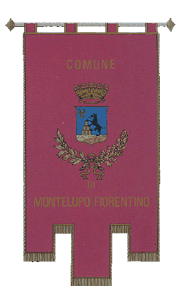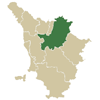|
 Inhabitants in 1991: 10.064 Inhabitants in 1991: 10.064
 The
municipal territory of Montelupo Fiorentino extends for 24,60 square kilometres
in Valdarno Inferiore. it had its origins as Seat of a Medieval Podesta
Office. A modest group of houses called Malborghetto at the
influx of the river Pesa into the Arno existed in the place where the
Fiorentini, in order to confront Pistoia and the stock of the
Counts Alberti da Capraia their allies, erected in 1203 an armed castle
with the aim of making the passage of the Arno and the access to the valley
of Pesa safer; according to the chronicles the name itself should have
sounded like a derisive warning to the enemy (Monte Lupo meaning Mountain
Wolf and Alberti da Capraia meaning Alberts of the Goats). The
municipal territory of Montelupo Fiorentino extends for 24,60 square kilometres
in Valdarno Inferiore. it had its origins as Seat of a Medieval Podesta
Office. A modest group of houses called Malborghetto at the
influx of the river Pesa into the Arno existed in the place where the
Fiorentini, in order to confront Pistoia and the stock of the
Counts Alberti da Capraia their allies, erected in 1203 an armed castle
with the aim of making the passage of the Arno and the access to the valley
of Pesa safer; according to the chronicles the name itself should have
sounded like a derisive warning to the enemy (Monte Lupo meaning Mountain
Wolf and Alberti da Capraia meaning Alberts of the Goats).
The castle, once it had tamed the riotous Counts of Capraia
was reduced to a modest observation point, given over to the care
of a chatelaine and a few soldiers, while at is feet the same name
village was developing and was soon surrounded by walls. In 1325
Castruccio Castracani put the village to "fire and sword" and the
following year the Firenze municipal ordered them to erect new and
ampler walls surrounded the township. In the immediate neighbourhood
Ferdinando I dei Medici, at the start of the XVII century, had
erected, on the design of Buontalenti, the villa called Ambrogiana.
Montelupo suffered severe damage during the last war, when nearly
half the buildings were destroyed or gravely damaged. At Montelupo
was born the sculpture and architect Bartolomeo Sinibaldi, better
known as Baccio da Montelupo (1469-1535).
Places to visit:
The Castle, on the top of the
hill the ruins and the high tower hosts the house of Baccio da Montelupo,
a 1500s well and the priory of S. Lorenzo, with fragments of murals
from 1284.
Pallazzo del Podestà, 1300 building
endowed with a portico and arcade, has a facade rich with heraldic
coats of arms Hosts the Museum of archaeology and ceramics.
S. Giovanni Evangelista, parish church with three naves,
it was remade in 1756. |
Historical info reproduced upon authorization of Regione Toscana - Dipartimento della Presidenza E Affari Legislativi e Giuridici
Translated by Ann Mountford |